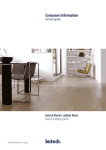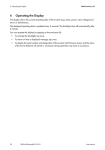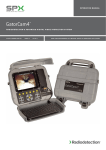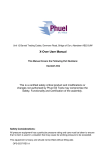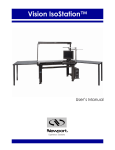Download WORKSTATION QUICK START GUIDE
Transcript
WORKSTATION QUICK START GUIDE This guide will help you to quickly get your isolated workstation system floating. Follow the basic steps below and refer to your user’s manual for more details. If you do not have an isolated workstation, please refer to the user’s manual for assembly instructions. For Self-leveling Isolators (I-125, I-250, I-325, I-500, I-800 series): 1) Make sure the ARF control knob is in the “OFF” position by turning the knob counterclockwise. Use the translucent tubing provided to connect the ARF inlet to your air supply. 4) After the table top has been installed, but before the isolators have been pressurized, remove the two Philips-head shipping screws located on the sides of each isolator. (VH only) ARF pressure control knob ARF inlet. Connect your air source here Figure 3 - Shipping Screw Figure 1 – ARF 2) Lift the tabletop and carefully set it on the frame. 3) Adjust the four leveling pads using the provided wrenches until the table top contacts evenly on all four of the legs and does not rock when pressed down at any of the four corners. Check the level of the table using the provided bubble level, or equivalent, making any necessary adjustments to the four leveling pads. 5) Make sure that the pads on each of the three leveling valve arms are in contact with the underside surface of the table top. Figure 4 - IPV Leveling Valve Figure 2 – Leveling Pad & Bubble Level 6) Fully close (turn clockwise) the needle valves located on the leveling valves (Fig. 5a). Then open each needle valve approximately 1/8 turn on each valve that supplies one isolator. For the valve that controls two isolators, open it 1/4 turn. For Air Mount Isolators (SLM series): 7) Slowly turn up the air pressure with the ARF (Fig.1) until the table is floating. Adjust the leveling arm (Fig. 5b) until the table top is floated above the flange of the isolator module by 0.175 inch (4.4 mm). Do not exceed the maximum allowable 2 system pressure of 90 psi (6.3 kg/cm ). Do not attempt to disconnect the tubing once the system is pressurized. The SLM series does not require a constant air source. Install the (4) provided adapter plates into the frame and mount the SLM air mounts on top of the plates. Follow steps 2 and 3 for the selfleveling isolators and then use an air compressor, foot pump, or equivalent to inflate each air mount individually. 8) Once the tabletop is loaded to the expected working load, the system air pressure should be adjusted to a level high enough so the top floats in a stable manner and maintains the 0.175 inch (4.4 mm) clearance from the leg tops. For Elastomeric Isolators (ND series): The ND series does not require any air input. Install the (4) provided adapter plates into the frame and mount the ND elastomers on top of the plates. Follow steps 2 and 3 for the self-leveling isolators. Table top (a) Needle valve adjustment screw 0.175” Isolator shipping screws (VH only - remove before pressurizing system) (b) Leveling arm adjustment screw Figure 5 – Leveling valve details Fine Tuning Steps: For optimizing performance, use the ARF and the leveling arm and the needle valve adjustment screws. ??Make sure the air pressure is only 5-10 psi above the required floating pressure established in step 8. Having the pressure too high will decrease isolation performance. ??Turning the leveling arm adjustment screw clockwise will move the leveling arm downward and cause more air to flow into the isolator, raising it higher. Turning the leveling arm screw counter-clockwise will move the leveling arm upward and cause air to flow out of the isolator, lowering that particular isolator. Use this adjustment to make sure all isolators are floating evenly. ??The needle valve will control the flow going through the valve and to the isolator. If you are experiencing some oscillation problems, try closing the needle valve slightly.


